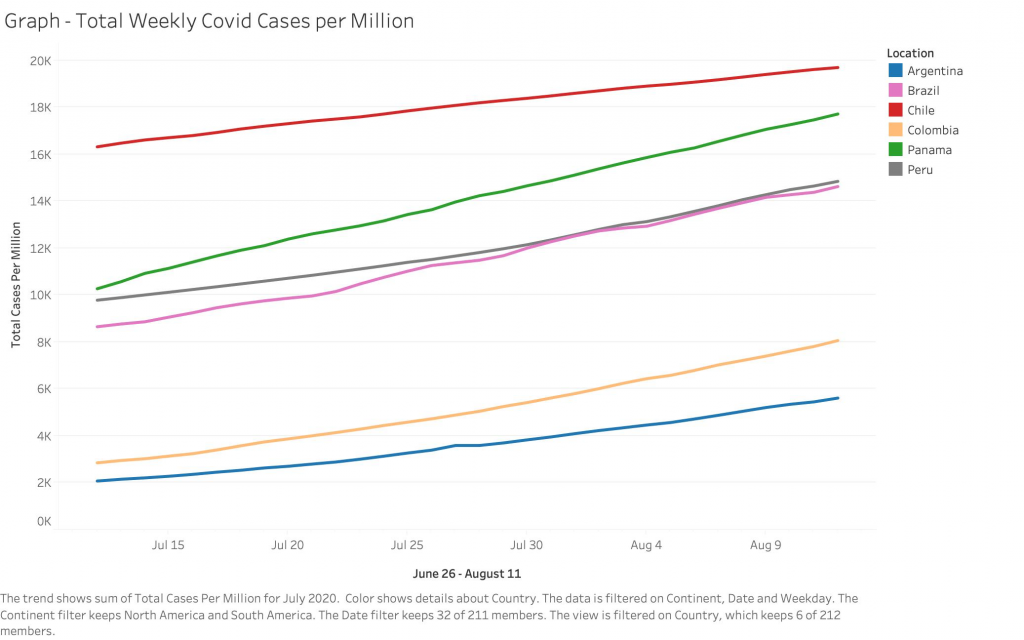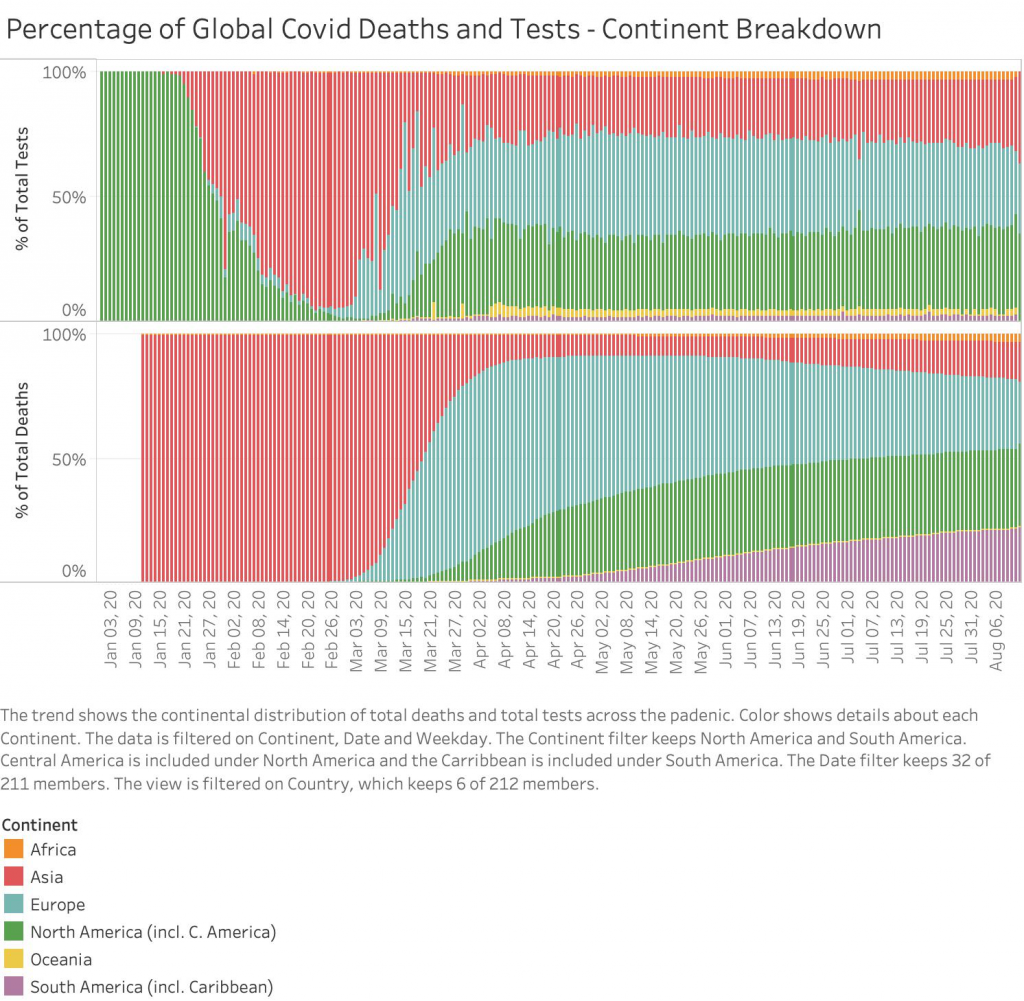Five things to know
- More than 20 million COVID-19 cases have been confirmed globally, with 5.4 million cases recorded in Latin America and the Caribbean.
- Argentina (mAbxience) and Mexico (Carlos Slim Foundation) announced on August 12 that they will work together to produce and distribute the AstraZeneca vaccine across Latin America, except Brazil, that signed a separate agreement. Mexico will produce between 150-250 million vaccines, which would be available in the first half of 2021.
- On August 6, Brazil’s President Jair Bolsonaro issued a decree providing $356 million to purchase and eventually produce the potential COVID-19 vaccine being developed by AstraZeneca PLC and Oxford University researchers.
- This week, the Pan American Health Organization leveraged its Strategic Fund for Public Health Supplies to procure and distribute millions of COVID-19 diagnostic kits, Personal Protective Equipment (PPEs), and other essential health supplies to countries throughout Latin America.
- Mexico surpassed 50,000 COVID-19 deaths, becoming the world’s third-highest death toll, after the United States and Brazil.
By the numbers
- Cases by country: Brazil (3,057,470) #2 worldwide, Mexico (485,836) #6 worldwide, Peru (483,133) #7 worldwide, Colombia (397,623) #8 worldwide. Chile (375,044) #9 worldwide, Argentina (246,486) #18 worldwide. Source: ourworldindata.org
- Prevalence rate (confirmed cases per million people): Chile (19,763) #5 worldwide, Panama (17,901) #6 worldwide, Peru (15,097) #10 worldwide, Brazil (14,903) #12 worldwide, Bolivia (8,132), Mexico (3,534) [see full list below] source: ourworldindata.org
- Deaths – total reported in the region: near 222,000 from 28 countries. Country breakdown: Brazil (101,752) #2 worldwide, Mexico (53,003) #3 worldwide, Peru (21,276) #9 worldwide, Colombia (13,154) #12 worldwide, Chile (10,139) #14 worldwide, Ecuador (5,932) #20 worldwide [see full list below] source: ourworldindata.org
Quarantine & reopening plans
Over the last week, some countries continued to reopen, balancing economic and public health concerns.
- On August 10, the government of Mexico City allowed bars to begin operating as restaurants at 30 percent capacity.
- In Panama, the government will allow certain businesses to reopen on August 17.
School reopening is a common development across the region.
- On August 10, 10,000 students in San Juan province, Argentina, returned to schools with a hybrid online-offline system, socially distant classrooms, and sanitary kits supplied for each student.
- In Brazil, state-run schools in Manaus, capital of Amazonas state, were the first to reopen. The return to in-person classes in other states remains uncertain. Recent judicial rulings suspended the reopening of private schools in Brasília and the city of Rio de Janeiro. The state government of São Paulo delayed the reopening of public and private schools until October 7.
- Finally, in Haiti, schools reopened on August 10, with the Ministry of Education allowing no more than 30 students per classroom while recommending a distance of one meter between children.
While many countries continued their economic reopening and lockdown easement processes, others have chosen to reinstitute quarantine measures.
- In Cuba, Havana is back under strict lockdown conditions after an increase in COVID-19 cases.
- In El Salvador, the Supreme Court has ruled President Nayib Bukele’s reopening plan unconstitutional, giving him two weeks to revise it.
- Over the last two months, Bukele has postponed the second phase of economic reopening three times.
International travel restrictions
- Most countries continue to uphold widespread travel restrictions to slow the spread of COVID-19.
- Brazil resumed international travel on July 29 with new rules for foreigners, including purchasing health insurance for the duration of their stay and/or providing a negative COVID-19 test upon arrival.
Economies in focus
- Economic Impact: A new report by UNICEF Argentina estimates that due to the impact of the coronavirus pandemic, child poverty will reach 62.9 percent by the end of 2020, an increase of 18.7 percent from last year. The country is projected to experience one of the worst regional economic contractions, about 12.5 percent, by the end of the year.
- Bolivia’s national statistics institute released new data on GDP growth for the first quarter of 2020. The latest numbers show that the country only grew 0.6 percent, the economy’s worst performance since 2001.
- In Ecuador, there are over 1 million people unemployed, about 13 percent of the economically-active population.
- Inflation: Both Chile and Colombia have experienced lower inflation rates than those projected by their Central Banks.
- In Chile, inflation in the 12 months to July hit 2.5 percent, tending toward the low end of the central bank’s target range.
- Colombia saw zero monthly inflation in July, bringing annual inflation to 1.97 percent, the lowest level recorded since July 2013.
- Contrastingly, Mexico’s annual inflation for July rose to its highest level in five months.
- Economic Relief: On August 7, Panama’s National Bank and its Ministry of Economy and Finance announced a new $150 million fund to help micro-, small and medium-sized enterprises through the COVID-19 crisis, as well as a $500 million fund to stimulate the banking sector.
- Additionally, in Colombia, President Iván Duque announced a new investment program called “Commitment to Colombia,” intended to generate one million jobs over the next two years to counteract the economic impacts of the pandemic.
Health and innovation
A Message from PhRMA: Biopharmaceutical companies are sharing their knowledge and resources more than ever before to speed up the development of new medicines to fight COVID-19. They’re working with doctors and hospitals on over 1,432 clinical trials. Because science is how we get back to normal. Learn more.
- On August 10, Argentina began clinical trials for the Pfizer and BioNTech COVID-19 vaccine.
- On August 12, a Brazilian technology institute in the state of Parana announced that it had signed an agreement with Russian authorities to produce a controversial Russian vaccine by the second half of 2021. Other countries, including Guatemala, Nicaragua, and Venezuela, are also working with Russia to test, produce, and distribute the Russian vaccine.
- On August 11, Mexico announced that it would host advanced-phase clinical trials of COVID-19 vaccines being developed by US (Janssen Pharmaceuticals/Johnson and Johnson) and Chinese (CanSino Biologics Inc.) companies, two of which could partly manufacture those products in the country.
- Peru is expecting to begin clinical trials in September for COVID-19 vaccines from US and UK laboratories, while also negotiating agreements with China to have access to vaccines at preferential prices.
By the numbers
- Cases by country (continued): Ecuador (87,041), Bolivia (81,146), Panama (68,456), Dominican Republic (73,117), Guatemala (51,542), Honduras (43,794), Venezuela (20,206), Costa Rica (19,402), El Salvador (17,843), Source: ourworldindata.org
- Prevalence rate (continued): Domincan Republic (6,968), Colombia (6,787), Ecuador (5,030), Argentina (4,878), Honduras (4,547), Costa Rica (4,004), Guatemala (2,982), , El Salvador (2,881), Suriname (2,572), Haiti (661), Paraguay (849), Venezuela (784), Source: ourworldindata.org
- Deaths (continued): Argentina (3,667), Bolivia (3,228), Guatemala (2,013), Panama (1,497), Dominican Republic (1,183), Honduras (1,384), El Salvador (486), Haiti (166), Venezuela (174), Costa Rica (171), Nicaragua (116), Cuba (87), Paraguay (55), Uruguay (36), Suriname (27). Source: ourworldindata.org
Graphs



